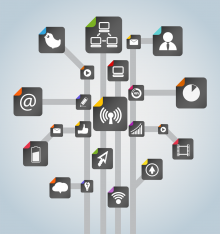Learning Technology for 400 students
At Winchester School of Art, and specifically the School-wide module ‘Research and Communication Skills (RCS)’ which I convene, Blackboard is used not as a standalone tool but as a facilitator to introduce a host of learning technologies with the aim of encouraging see through learning.
“Technology that is transparent is easy to use and has little demands on the cognitive energy of the user. Transparent technology is often referred to as ‘user friendly’ in that it allows the user to ‘see through’ the device into what it is able to do for them.” (John & Wheeler, 2008; p 96)

A barrier to the see through learning or user friendliness can result from undirected requests for students to simply access materials within an unknown Virtual Learning Environment (VLE). The VLE is then seen purely as a document store and not an extension of the classroom.
Often this can be due to less thought being given to ensure that experiences designed within the class could be applied to the VLE. Key within HE is encouraging and promoting the seamless transition from classroom activities to peer learning, self directed and life long learning. Directed tasks relating to the use of digital learning technologies can really enhance and improve this if well designed.
Within RCS we facilitate removing this unfriendly barrier of using a VLE which by the nature of it being via a computer it is often devoid of personality by directing students through a constructed and aligned set of objectives and learning outcomes within the VLE.

Each student completes a short blog entry each week on a course wide Wordpress blog (integrated and accessed via Blackboard) Each entry is based on their own reflection on a specific Art & Design activity, such as utilising digital resources within the VLE or library for research or debates on ethics with a task and example outlined within the weekly group session.
“The discipline of being obliged to formulate one’s ideas, thoughts, reactions and opinions in writing is such as way that their meaning is clear to other people who are not physically present, is of key importance in the majority of educational programmes. (Kaye 1989 p10)” (Butcher, Davies & Highton, 2006; p 79)
These sessions and the blog outcomes are designed to work across the full range of Visual Auditory Kinaesthetic (VAK) learning modes. Sessions are highly visual, often containing video, imagery, discussion, buzz groups, zappers and more. Every session is recorded using Panopto which is again integrated within Blackboard. In this way the module can engage with students in a variety of methods and styles as well as introduce key digital learning techniques within a directed and safe environment. The principle is to apply the experiential learning cycle not only within the face to face sessions but also within an integrated VLE. (Here integrated VLE refers to our integrated use of Blackboard (module documents (slides & text) EdShare teaching and learning materials, Lynda.com, Panopto and Wordpress.)
Within the RCS module the evidence in the blogs and feedback indicate strongly that the most effective way to utilise and engage students with learning technologies is to ensure there is a cohesive, playful and connected strategy rather than the simple use of an isolated or disconnected VLE. Comments often focus on the use of the blog platform, the zappers, Panopto, EdShare and the VLE structure as a very positive and upbuilding learning experience.
Blackboard has some way to go to be truly user friendly. Some of the most seamless and friendly systems inject even more personality and play.

458 WORDS
QUESTIONS FOR DISCUSSION
What do you think as educators, could make a friendly VLE ? Is Future Learns bright, bold and weekly structure better than Blackboards folder (PC style) structure ?
This is a large module for almost 400 UG students and so technology helps mediate this. Perhaps there is a case for purely providing slides or documents only via the VLE if there is more face to face time; why complicate things with Panopto and multimedia material ?
REFERENCES
John, P. D. and Wheeler, S. (2008) The Digital Classroom: Harnessing Technology for the Future. London: Routledge.
Butcher, C., Davies, C. & Highton, M., 2006. Designing Learning, Routledge.
Francis, P., 2009. Inspiring Writing in Art and Design, Intellect Books.
Riding, R. & Rayner, S., 2013. Cognitive Styles and Learning Strategies, Routledge.
Honey, P. & Mumford, A., 1992. The Manual of Learning Styles,
Honey, P. & Mumford, A., 1996. How to Manage Your Learning Environment,
Kolb, D.A., 1984. Experiential learning, Ft Pr.
Wheeler,S., The survival of Higher Education (4): 5 key objectives. Available at: https://steve-wheeler.blogspot.co.uk/2014/02/the-survival-of-higher-education-4-5.html?q=play [Accessed March 3, 2014].
IMAGES
https://www.kbz.com/blog/my-networked-life-using-connected-technologies-collaboration
https://www.creativereview.co.uk/back-issues/creative-review/2006/september-2006/a-life-in-pixels